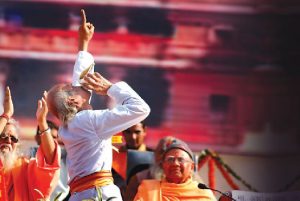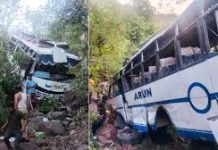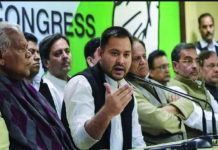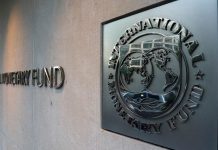The Supreme Court on November 9 paved the way for construction of much awaited Ram Temple on the site of Babri mosque that had been demolishedby frenzy Hindutva mob in Ayodhya, Uttar Pradesh on December 6, 1992. The apex court cleared the decks for temple on disputed land but simultaneously ordered five acres of different land to be allotted to Sunni Waqf Board for construction of Mosque in Ayodhya. The Bench also held that the destruction of the Mosque was against the rule of law.
The Court also directed the Centre to come up with a scheme envisaging the setting up of a trust. The possession of the inner and outer courtyards of the dispute structure has to be given to this trust. The scheme should provide for construction of a temple at the dispute site, the Court observed.
Nine years after the Allahabad High Court’s verdict in the Ayodhya case, the Supreme Court afive judge constitution bench headed by chief justice of India Ranjan Gogai with Justices SB Bobade, Dr. Dhananjay Chandrachud, Ashok Bhushan and S Abdul Nazeer unanimously ordered the government to acquire land on an alternative site for a mosque to be built. The dispute, which dates back over a century, concluded after 40 days of intensely loaded arguments in the Supreme Court.
The apex court dismissed the Suit 3 instituted by Nirmohi Akhara as barred by limitation whereas Suit 4 instituted by the Sunni Central Waqf Board and other plaintiffs are held to be within limitation. The court reversed the judgment of the High Court that dismissed the Waqf Board suit on the grounds of limitation. The court held Suit 5 file on behalf of deities as its next friend to be within limitation.
The apex court directed that the Central Government shall, within a period of three months from the date of this judgment, formulate a scheme pursuant to the powers vested in it under Sections 6 and 7 of the Acquisitionof Certain Area at Ayodhya Act 1993. The scheme shall envisage the setting up of a trust with a Board of Trustees or any other appropriate body under Section 6.
The court further elaborated that the scheme to be framed by the Central Government shall make necessary provisions in regard to the functioning of the trust or body including on matters relating to the management of the trust, the powers of the trustees including the construction of a temple and all necessary, incidental and supplemental matters. Possession of the inner and outer courtyards of the demolished shrine shall be handed over to the Board of Trustees of the Trust or to the body so constituted. The Central Government will beatliberty to make suitable provisions in respect of the rest of the acquired land by handing it over to the Trust orbody for management and development in terms of the scheme framed in accordance with the above directions.
The apex court using its powers under Article 142 that empowers it to do complete justice in a matter, directed for the allotment of land to the Sunni Central Waqf Board in Suit 4 and framing of a scheme wherein appropriate representation may be given in the Trust or body, to the Nirmohi Akhara in such manner as the Central Government deems fit.
Simultaneously, with the handing over of the disputed property to the Trust or body under clause 2 above, a suitable plot of land measuring 5 acres shall be handed over to the Sunni Central Waqf Board by the Central Government or State Government. Sunni Wakf Board at liberty to construct a mosque at the allotted land.
The landshall be allotted either by: (a) The Central Government out of the landacquired under the Ayodhya Act 1993; or (b) The State Government at a suitable prominent place in Ayodhya.The Central Government and the State Government shall act in consultation with eachother to effectuate the above allotmentin the period stipulated. The court decreed the suit in terms of clear directives.
The court also affirmed the right of the Nirmohi Akhara to worship at the disputed property subject to any restrictions imposed by the relevant authorities with respect to the maintenance of peace and order and the performance of orderly worship.
The Supreme Court has accepted the Allahabad High Court view that idols were placed inside the central dome of Babri Masjid on the intervening night of December 22-23 in 1949. It added that underlying structure which was “not Islamic in nature”. The artefacts recovered have a distinct non-Islamic nature.The court said that it can’t reject the Archaeological Survey of India (ASI) report as conjectura. “The ASI report leads to the conclusion that Babri mosque was not constructed on vacant land.”
Ayodhya Dispute Chronology
1529: Babri Mosque constructed by Mir Baqi.
1885: Court Dispute Begins — Mahant Raghubir Das files the first suit in the matter, seeking to build a temple on land adjoining the mosque. The Faizabad District Magistrate (DM) refuses him permission. Next, Mahant Raghubir Das files a title suit in Faizabad Court against the Secretary of State for India, seeking permission to build a temple on the chabutra (courtyard) of the Babri mosque. Faizabad Court rejects his plea.
Dec 1949: Ram Idol Appears inside the Mosque – On the night of 22nd December, a Ram Idol appears inside the mosque. Hindus see the appearance of the Idol as a divine revelation, however many argue that the Idol was smuggled inside at night. Hindus start offering prayers.
The Government declares the site as a “contested area” and locks the entrance.
1950: Hindu sides file Suits — Two suits are filed in Faizabad Court by Gopal Simla Viharad and Paramhansa Ramachandra Das, seeking permissiong to conduct Hindu pujas to Ram Lalla. The Court granted the parties permission to conduct pujas. The Court orders the inner courtyard gates to remain locked.
1959: Third Hindu suit filed — Nirmohi Akhara files third suit, seeking possession of the land.
1961: Muslim suit filed — UP Sunni Wakf Board files a suit seeking possession of Babri Mosque site. They also demand the removal of Ram Idols from Babri Masjid.
1984: Ram Janmbhoomi Movement commences — Vishwa Hindu Parishad (VHP) constitutes a group to start the Ram Janmbhoomi Movement. BJP leader LK Advani is made the leader of the campaign.
1st February, 1986: Inner Gate of Babri Mosque opened — A third party, lawyer UC Pandey appeals for the gates to be unlocked before the Faizabad Session Court, on the grounds that the Faizabad district administration, and not a Court, had ordered its closure.
District Judge orders the locks to be removed to allow Hindu “pooja and darshan”. Muslims constitute a Babri Mosque Action Committee (BMAC) in protest.
November 9, 1989: Shilanayas performed – PM Rajiv Gandhi allows the VHP to perform Shilanayas (laying of foundation stone) near disputed area.
1989: All title suits shifted to Allahabad High Court. Another suit in name of Ram Lalla Virajman filed in the High Court, naming the parties in the Nirmohi Akhara (1959) and Sunni Waqf Board (1961) suits as defendants.
September 25, 1990: Rath Yatra — LK Advani launches a Rath Yatra from Somnath (Gujarat) to Ayodhya (UP) to incite support for the Movement. Communal riots break out.
December 6, 1992: Babri demolished – Babri Mosque razed by violent mob of Karsevaks. The Karsevaks leave behind a make-shift temple in
its place.
December 16, 1992: Liberhan Commission formed — 10 days after the Mosque was demolished, the PM forms a committee led by retired High Court Judge M. S. Liberhan, to look into circumstances leading to the demolition of the Babri Mosque and the communal riots. The Commission was originally mandated to submit its report within three months of its formation.
January 7, 1993: State acquires Ayodhya land — Narsimha Rao Government issues an ordinance acquiring 67.7 acres of land (Site and adjoining areas). Later it was passed as a law — Acquisition of Certain Areas at Ayodhya Act, 1993 to facilitate acquisition of land by Central government.
1994: Ismail Faruqui Judgment — The SC by a majority of 3:2 upheld the constitutionality of Acquisition of Certain Areas at Ayodhya Act.
The majority judgment by former CJI JS Verma reasoned that every religious immovable property is liable to be acquired. The SC adjudged that offering namaz at mosque was not integral to Islam unless that mosque had any particular significance in Islam. The judgment has been criticized for regarding the mosque as a non-essential place of worship.
There were no reviews filed against Ismail Faruqui
April 2002: Ayodhya Title Dispute case begins — The Lucknow Bench of the Allahabad High Court begins hearing Ayodhya Title Dispute.
March — August 2003: ASI Survey — Archaeological Survey of India begins excavating the land underneath the disputed site on the directions of the Allahabad High Court. It claims to have found remnants of a 10th century Hindu Temple. Muslims question the ASI report.
June 30th, 2009: Liberhan Commission report submitted — After a delay of 17 years, the Librehan Commission submits its report to the Prime Minister, though its contents are not made public.
September 30, 2010: Allahabad HC splits land in three ways — The High Court delivers its judgment, dividing the land between three parties: one third for the Sunni Wakf Board, one third for the Nirmohi Akhara and one third to Ram Lalla Virajman.
The judgment of the Lucknow Bench of the HC of September 30, 2010, which divided the disputed land in Ayodhya in 2:1 ratio among the Muslim and Hindu litigants.
The HC allotted the dome of the demolished Babri Masjid, under which the makeshift temple currently stands, to the Hindus. The structure was demolished by a group of Karsevaks on December 6, 1992. The nearby Ram Chabutra and Sita Rasoi also went to the Nirmohi Akhara. The one-third share of the Sunni Wakf Board comprise the outer courtyard of the disputed land.
May 2011: Supreme Court stays Allahabad High Court ruling — The SC admits a batch of petitions filed by all parties. A Division Bench of Justices Aftam Alam and R.M. Lodha term the High Court Judgment as “strange”. RM Lodha observs “a new dimension has been given by the High Court as the decree of partition was not sought by the parties. It was not prayed for by anyone. It has to be stayed. It’s a strange order. How can a decree for partition be passed when none of the parties had prayed for it?..”
March 21, 2017: Former Chief Justice Khehar suggests an out of court settlement among all parties.
August 11, 2017: 3 judge bench of SC starts hearing the matter — The 3 judge bench of SC comprising CJI Dipak Misra, Justices Ashok Bhushan and Abdul Nazeer began hearing the appeal.
Feb — July 2018: The petitioners argue that the SC ought to refer the 1994 Ismail Faruqui judgment to a 7-judge Bench for reconsideration.
July 20, 2018: SC reserves verdict — The SC reserves judgment on the question of referring the appeal to a larger Bench
September 27, 2018: SC refuses to form a larger Bench — The 3 judge bench in a split of 2:1 verdict held that the Ismail Faruqui judgment of 1994 does not require reconsideration by a larger bench.
The Key Players
Decades after the Babri mosque was razed in Ayodhya, most of those who played in major role in the campaign to build a Ram temple there are still leading figures in Indian politics.
L.K. Advani: He was the face of the Ayodhya temple movement. His ‘rathyatra’ from Somnath to Ayodhya (halted in Bihar) led to widespread riots. He later called the Babri razing a matter of regret. Went on to be deputy prime minister. Unlike former prime minister AtalBihari Vajpayee, his closest confidant in politics, Advani chose to become the hardline face of the temple movement. Born in 1927 in the Sindh province of present-day Pakistan, Advani too got associated with the RSS very early in his life, becoming a pracharak in 1941. After Partition, he was sent by the Sangh to Rajasthan. His role changed in the early 1950s as the Bharatiya Jana Sanghwas formed as a political offshoot to promote the RSS ideology. In 1957, he was moved to Delhi to look after the party’s affairs. In 1980, the Bharatiya Janata Party was formed. Vajpayee became its first president. The party’s guarded approach towards the Ram Janmabhoomi issue didn’t pay any significant dividend in the 1984 general elections that were held amid nationwide outrage after Prime Minister Indira Gandhi’s assassination.
Following this, the BJP shifted to politics of staunch Hindutva and no-holds-barred commitment to the issue of Ram Mandir. It also triggered a transformation in Advani’s political profile. He was brought in as the president of the BJP. From then, he became the most aggressive voice and campaigner from the BJP for the temple campaign. Though the likes of Vajpayee and Joshi did play their part, Advani clearly was leading the pack.
In 1990, as the temple movement was at its peak, Advani took on the most controversial and virulent campaign of his political career — the Ram RathYatra, from Somnath in Gujarat to Ayodhya in Uttar Pradesh. Present prime minister Narendra Modi was the architect of Advani’syatra plans. The procession though never reached Ayodhya, as it was stopped and Advani was arrested by the-then Bihar chief minister Lalu Prasad Yadav’s administration. But the purpose was fulfilled. Advaniwas established as the hardline face of the Ram temple cause. Two years later, the Babri Masjid was brought down by karsevaks. In recent years, Advani found himself slowly sidelined in the party with new leadership emerging under Narendra Modi. Today, though he is a member of the Lok Sabha, he is part of the nondescript “margdarshakmandal” (group of mentors) of the BJP. But at 92 years of age, when most of his associates have passed away, Advani is the only one who has witnessed the resolution of Ayodhya dispute.
PV Narasimha Rao: The tenure of the ninth prime minister of India, from 1991 to 1996, witnessed the demolition of Babri Masjid occurred, triggering communal rights. It is believed that Rao chose not to impose central rule in Uttar Pradesh, where Ayodhya is located when tensions were escalating. It may be recalled that more more than 25 years ago, the government had brought an ordinance for Ram Mandir in Ayodhya. It happened in January 1993, only a month after the Babri Masjid was brought down by a massive assembly of karsevaks participating in a movement led by the Vishva Hindu Parishad on December 6, 1992. Back then, P.V.NarasimhaRao was the Prime Minister.
The Ram Mandir Ordinance and the subsequent Ayodhya Act had been brought “to acquire the site of the disputed structure and suitable adjacent land for setting up a complex” that would have a temple dedicated to Lord Ram. The NarasimhaRao government acquired 60.70 acre land surrounding the disputed site of
2.77 acre.
The Congress government planned to build “a Ram temple, a mosque, amenities for pilgrims, a library, museum and other suitable facilities” in Ayodhya. But, the Ayodhya Act failed to pave way for a Ram Mandir. The BJP vehemently opposed the NarasimhaRao government’s moves — the ordinance and also the Ayodhya Act. The then BJP vice-president SS Bhandaricalled it “partisan, petty and perverse”. Muslim bodies also opposed it. The minority government of NarasimhaRao developed cold feet and sought refuge in the Supreme Court through a Presidential Reference under Article 143 of the Constitution. Rao passed away in 2004.
Kalyan Singh: Kalyan Singh, who was the chief minister of Uttar Pradesh when Babri Masjid in Ayodhya was razed down in 1992. Singh was appointed as the Rajasthan Governor in September 2014. He was also an accused in Babri demolition case along with BJP veterans Lal Krishna Advani, Uma Bharti and MurliManohar Joshi. A firebrand Hindutva leader and prominent face of the Ram mandir movement, his government was dismissed after Babri Masjid demolition. His return to active politics is being seen by political analysts as yet another push by the BJP to Hindutv agenda ahead of 2022 Uttar Pradesh assembly polls.
The face of Kalyan Singh can work wonders for the BJP when it comes to pushing the agenda of Ram Mandir ahead of 2022 state assembly polls.
Murli Manohar Joshi: Was a strong and vocal advocate of a Ram temple at the Babri site. He witnessed the mosque razing and was photographed joyously hugging Uma Bharti. Remains a senior leader of BJP.
Vijayaraje Scindia: She was an uncompromising opponent of the Babri mosque, which was said to be at the birthsite of Lord Rama. She later gave up electoral politics. She died in 2001.
Uma Bhrati: The firebrand face of the Hindutva movement, she raised slogans such as ‘Ram namsatya hai, Babri Masjid dhvasth hai’ as the Babri mosque was razed. Later became chief minister of Madhya Pradesh. She quit the BJP and then returned to the party.
Ashok Singhal: The best known face of Vishwa Hindu Parishad (VHP), which prepared the ground for the pro-temple movement that helped the BJP to grow and grow. He died on 17th November, 2017.
Sadhvi Rithambhara: Like Uma Bharti, she was another firebrand face of the Hindutva movement. She addressed innumerable meetings inciting people to destroy the Babri mosque. Now immersed in spiritual work.
Vinay Katiyar: VinayKatiyar is the founder-president of Bajrang Dal, the youth wing of the Hindu nationalist organisation Vishwa Hindu Parishad in India. He has served as a National General Secretary of the Bharatiya Janata Party, and as a Member of Parliament in both the Lok Sabha and the Rajya Sabha. On November 30, 1992, he had said ominously: “Kuchbigadegatabhikuchbanega.” He was later the Lok Sabha member from Faizabad (Ayodhya).
Bal Thackerary
The Shiv Sena chief was never present at the site of the demolition, but his organisation had played a key role in the bringing down of the mosque. The Shiv Sena founder had praised the demoliton of mosque. Thackeray died in 2012 aged 86.
Lalu Yadav
RJD leader Lalu Yadav was the chief minister of Bihar in 1990 and went down in history for his decisive stand against Advani’s rath yatra. He ordered Advani’s arrest from Bihar’s Samastipur on 23 October.
Hashim Ansari
Ansari was one of the oldest litigants in the Ramjanmabhoomi-Babri title suit. He was the only one of the six plaintiffs of the Babri Masjid case fighting for the mosque title on behalf of the Sunni Waqf Board since 1961. He claimed to have witnessed the placing of the idol of Ram Lalla inside the mosque in 1949. He died in 2016 at the age of 96.













